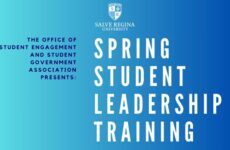By: Amanda Valentine | Staff Writer
Even though climate change is one of the world’s most pressing issues, it unfortunately happens to also be one of the most controversial and divisive. Conflicting opinions on the existence of climate change have hindered national and global efforts to slow down global warming since concerns first arose.
The sheer magnitude of the problem tends to leave people feeling clueless as to what they can do. They also often feel that if they did do something, it would bear little impact anyway, and is therefore pointless. On the contrary, due to the size of the problem, it becomes all the more important for each individual to do their part: a problem as widespread as the warming of the entire planet cannot depend on the efforts of just a few.
Salve Regina’s founding Sisters of Mercy put forth five critical concerns of Mercy which the campus ideally works to support. One of these five is the environment, giving Salve a moral responsibility to rally for sustainability on campus.
To put the critical concerns in a global context, the Pope himself has been urging Catholic followers, and the world as a global community, to make changes to their thus far feeble efforts.
Salve has reacted in accordance to the rising concern about global warming. A time-consuming but highly beneficial process to make changes has taken off in the past few years.
“We know that climate change will have its greatest impacts on some of the most vulnerable populations of people…so there’s lots of reasons why the campus should be concerned,” said Dr. Jameson Chace, chairman of Cultural, Environmental, and Global Studies department. “Aside from the impact it’s going to have on the general environment, but just the impact on people would be enough to get us to want to do something.”
You can step outside and see the effects of climate change on an everyday basis. Earlier this year, for some time in September, dragonfly swarms hovered over every field on campus. While they do migrate every year, the migrations of 2019 were incredibly large and widespread. This unusual occurrence is itself a likely consequence of a warmer climate, and just another example of the tangible, visual effects of global warming.
The more large-scale consequences are much more difficult to spot in action than dragonflies. The poorest populations around the world are facing the largest challenges of climate change, while the world’s richest populations are the ones causing it. As we sit in our consistently air-conditioned, well-lit rooms filled with mass-produced products, it can be difficult to remember the impact a wasteful lifestyle has on populations that are far, far away.
Therefore, in considering climate change it is important to remember not only the drastic effects on the environment itself, but also the people living in it. Rather than just being productive members of the Salve Regina campus, we must ask ourselves if we are being “good global citizens,” as Dr. Chace called it.
Chace noted that Salve Regina’s sustainability efforts had only covered the surface of what was possible, and he suggested that we have done “the things that any homeowner who is cognizant of saving money and protecting the environment would be doing.”
Eric Milner, Assistant Vice President of Facilities Management, confirmed that Salve’s efforts thus far have been mostly the “low hanging fruit” or the options which offer the greatest results for the least effort. As of right now, Milner said that “the focus has been more towards answering the question: how do we reduce the amount of electricity we use, and then also the amount of natural gas we use?”
In terms of electricity, our present efforts include changing all of our lighting over to LED technology. Milner reported that this effort began in the library, because the lights are on nearly all the time. The change of lighting in just this one building, according to Milner, “significantly reduced the amount of electricity we used.”
While the benefits of somewhat “easier” changes are not to be underestimated, there are many more changes that could be made to yield even greater results. The processes, however, are challenging and complicated. For example, there are restrictions that come with being a historic district. Milner reported that Salve was unable to put up a windmill due to these laws is unable to integrate solar panels. Despite this setback, Milner reports that Salve is in the process of partnering with other universities in Rhode Island to support local solar farms “so that they know that they have a market.”
The large-scale, campus-wide changes take time, money, and deliberation to integrate. However, with increasing awareness and concern, Salve Regina has a bright future in terms of sustainability efforts. This positive outlook is bolstered by the presence of President Kelli Armstrong in office. Previously the Sustainably Coordinator at Boston College, Armstrong is well-versed in the role a traditionally Catholic campus has in protecting the environment.
It is not up to Armstrong alone. Dr. Chace observed, “Is she going to do that if the trustees aren’t invested? Is she going to do that if the students aren’t invested? Is she going to do that if the staff isn’t invested? Probably not. She’s going to need to hear that from many different groups.”
The movement toward sustainably relies on the efforts of the individual. Change is incredibly dependent on people’s willingness to do it. Rather than being insignificant, adding one more voice to the conversation can make all the difference in manifesting real change.
“Our ability to be sustainable is very much predicated on people’s willingness to do it,” Milner said. “It can’t be other people doing it for you, it’s got to be one of those things that people embrace for themselves.”













